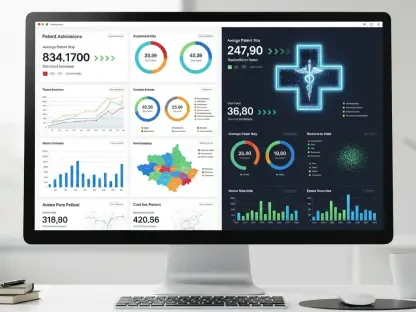Electronic Health Record (EHR) systems are a cornerstone of modern healthcare, significantly impacting the economic and operational health of medical institutions. This article explores the multifaceted ways in which EHR design influences financial stability, operational efficiency, and overall healthcare outcomes.
The Role of Workflow Optimization
Enhancing Efficiency and Reducing Errors
Modern EHR systems are designed to optimize clinical workflows, which directly contributes to the return on investment (ROI) for healthcare organizations. By streamlining processes and reducing manual tasks, these systems improve efficiency and minimize errors, leading to significant economic benefits. For example, a simplified medication reconciliation process within an advanced EHR system ensures that clinicians can review and update patient medication lists with just a few clicks. This streamlined approach not only saves valuable time but also reduces the chance of errors, which can lead to serious patient safety issues and financial liabilities. Furthermore, optimized EHR workflows facilitate faster patient throughput, enabling healthcare providers to see more patients without compromising the quality of care—a critical aspect in maximizing revenue.
Continuous Improvement
Workflow optimization is not a one-time effort but requires ongoing evaluation and updates. EHR vendors must regularly assess and refine workflows to ensure they remain efficient as organizational needs evolve, thereby maintaining their economic impact. Continuous improvement is essential because healthcare environments are dynamic, with clinical practices and regulatory requirements frequently changing. EHR systems that adapt to these changes can support healthcare organizations in maintaining high levels of productivity and compliance. Regular system updates also play a pivotal role in mitigating issues that arise from outdated processes, ensuring that healthcare providers can focus on delivering care rather than dealing with administrative inefficiencies. Additionally, a commitment to perpetual workflow enhancement signifies an organization’s dedication to quality improvement, a factor that can enhance its reputation and attract more patients.
Addressing Technical Debt
The Hidden Costs
Legacy EHR systems built on outdated architectures present hidden costs that can strain healthcare organizations. These systems are expensive to maintain and upgrade, diverting resources from innovation and leading to scalability issues, especially during mergers and acquisitions. Technical debt in EHR systems often necessitates significant financial investments to keep the technology running, detracting funds that could be better spent on upgrading facilities or hiring additional staff. In large health systems, the integration of new acquisitions can become a logistical nightmare if legacy systems are involved. This complexity arises because older systems lack the flexibility needed to seamlessly incorporate new data sources or ensure compatibility with modern standards, thus requiring costly, time-consuming workarounds.
Talent and Security Challenges
Outdated systems also struggle to attract technical talent and pose significant security risks. Frequent downtimes and vulnerabilities can disrupt operations, as evidenced by incidents where healthcare facilities had to revert to paper records following cyberattacks. Modernizing EHR systems is thus not only a matter of improving efficiency but also of attracting and retaining a skilled workforce. Talented IT professionals often seek opportunities where they can leverage the latest technologies, contributing to innovation and improving system reliability. Furthermore, outdated EHR systems are more susceptible to security breaches, which can have devastating consequences both financially and reputationally. Investing in modern EHR architectures reduces these risks by incorporating robust security measures, thus safeguarding patient information and maintaining the trust of both patients and providers.
Staff Satisfaction and Retention
Usability and Cognitive Load
The usability of an EHR system significantly affects staff satisfaction and retention. Systems that cause alert fatigue or require high click counts for routine tasks increase cognitive burden and frustration among healthcare providers. When clinicians are overwhelmed by frequent, often unnecessary alerts, their ability to focus on patient care diminishes, impacting both their productivity and job satisfaction. High cognitive load from inefficient EHR systems can lead to burnout, contributing to higher turnover rates and additional costs for recruiting and training new staff. Investing in user-friendly EHR designs that prioritize simplicity and efficiency can enormously enhance the workplace environment for healthcare professionals, leading to better patient outcomes and higher staff morale.
Customization and Reliability
Tailoring EHR workflows to specific specialties and ensuring system reliability are crucial for maintaining clinician trust and satisfaction. Poor integration with other clinical systems can lead to inefficient workflows and missed information, further impacting staff morale. Customization ensures that clinicians have access to relevant tools and data, which can be seamlessly integrated into their specific practice patterns. Reliability is equally important, as frequent downtimes or slow system performance can disrupt clinical care, erode trust, and increase stress among healthcare staff. Robust EHR systems that operate smoothly and interface well with other health IT systems foster a stable and supportive work environment. They minimize distraction and enable clinicians to spend more time on direct patient care, thus improving both provider satisfaction and patient outcomes.
The Integration Equation
Unified vs. Fragmented Systems
The shift towards unified enterprise solutions over fragmented systems offers substantial economic benefits. Unified systems reduce interface maintenance costs, streamline training and support, and enhance staff efficiency by eliminating redundant data entry. Eliminating the need for multiple interfaces simplifies both the clinician’s experience and the IT department’s workload, reducing the potential for errors and improving data accessibility. Unified systems also streamline onboarding processes for new staff, as they need only learn one cohesive system instead of multiple disparate tools. This efficiency not only saves time but also ensures consistency in data entry and retrieval, leading to more accurate and comprehensive patient records. Over time, the reduction in maintenance and training costs can significantly impact the financial health of healthcare organizations.
Data Analytics and Decision-Making
Unified EHR systems facilitate sophisticated data analytics, providing comprehensive access to patient data across the care continuum. This capability aids in clinical decision-making and financial planning, helping organizations identify opportunities for operational improvement and revenue optimization. Comprehensive data sets allow for better tracking of patient outcomes, identifying trends, and implementing evidence-based practices. Advanced analytics can pinpoint areas where resources are underutilized or where operational inefficiencies exist, enabling healthcare managers to make informed decisions that enhance care delivery and financial performance. Moreover, robust data analytics support population health management initiatives, helping organizations anticipate and address public health challenges effectively and proactively.
Future Economic Value
Modern Architecture and AI Integration
Looking ahead, the economic value of EHR systems will increasingly depend on their ability to integrate AI seamlessly. Systems that natively incorporate AI will stand out, helping healthcare organizations balance immediate feature needs with long-term architectural scalability. AI integration can revolutionize various aspects of healthcare, from predictive analytics and personalized medicine to automating routine administrative tasks. EHR systems designed with AI at their core can offer advanced decision support tools, such as real-time risk assessments for patient complications or dynamic treatment recommendations based on the latest research. These capabilities enable healthcare providers to deliver more precise, efficient, and personalized care, ultimately improving patient outcomes and system efficiency.
SaaS Models and Cost Management
Transitioning to System as a Service (SaaS) models can help healthcare organizations manage costs more effectively. These models integrate regular updates and hardware refreshes into fixed pricing structures, mitigating the need for unpredictable multi-million-dollar infrastructure investments. SaaS models provide a scalable, flexible solution that can evolve with the needs of the organization, offering continuous improvements without significant capital expenditures. This approach ensures that healthcare institutions always have access to the latest technological advancements, enhancing their capacity to deliver high-quality care. SaaS also simplifies budgeting processes, allowing organizations to allocate resources more efficiently and focus on strategic initiatives that drive growth and innovation.
Conclusion
Electronic Health Record (EHR) systems are integral to contemporary healthcare, dramatically shaping the financial and operational well-being of medical facilities. This discussion delves into the diverse aspects of EHR design and its far-reaching effects on financial stability, operational effectiveness, and overall patient care quality. By streamlining administrative tasks, reducing paperwork, and facilitating faster access to patient information, EHR systems enhance operational efficiency. Moreover, they improve financial outcomes by minimizing errors, optimizing billing processes, and aiding in better resource allocation. The design and implementation of EHR systems also influence healthcare outcomes by promoting accurate and timely patient data management, which leads to better decision-making and improved patient safety. Therefore, understanding the comprehensive impact of EHR systems is essential for medical institutions aiming to improve their economic resilience and operational effectiveness while delivering superior patient care.









